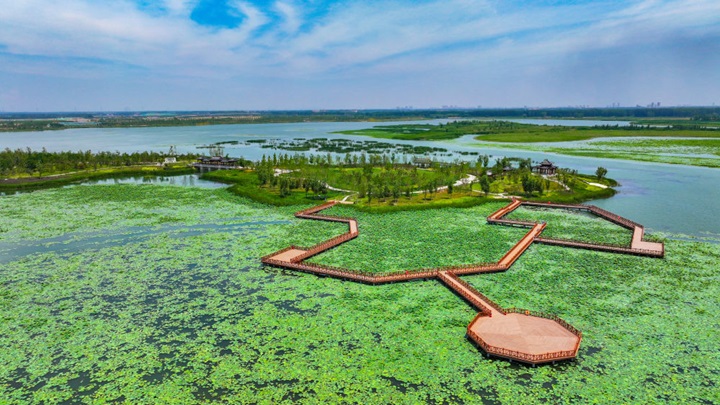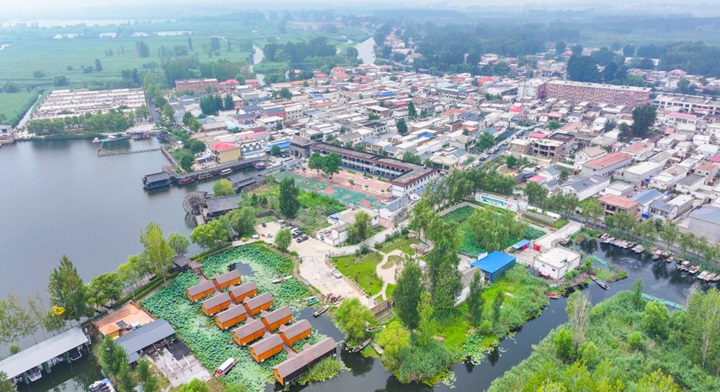During the midsummer season, tourists come and go on the wooden plank road at Yannandi in Baiyangdian, Xiong’an New Area, China’s Hebei province, eagerly holding up their mobile phones to capture the breathtaking scenery before them.

Baiyangdian, composed of 143 lakes and 3,700 ditches and trenches, is the largest wetland ecosystem in northern China and plays an irreplaceable role in maintaining the ecological environment of the region.
Due to factors such as industrial development and population growth within the watershed, pollution continued to increase, and Baiyangdian once faced an ecological dilemma.
In April 2017, the establishment of the Xiong’an New Area in Hebei Province marked a turning point. Following its establishment, large-scale and systematic ecological governance efforts in the Baiyangdian watershed have been vigorously advanced.
“We have successively carried out four phases of ecological dredging projects, which have improved the ecological self-purification capacity of Baiyangdian and promoted biodiversity,” said Zhou Lizhi, head of the Water Environment Management Group of the Ecological Environment Bureau of the Xiong’an New Area. The former marshy Shaochedian area, which was once a swamp, has now been transformed into the popular tourist attraction Yannandi, which is one of the achievements of the ecological dredging projects, he added.
A series of projects, including scientific water replenishment, desilting and dredging, connecting various lakes, returning farmland to lakes, and implementing rigorous flood control measures, have been synergistically promoted, rejuvenating Baiyangdian. The water quality in the lake area has improved from the inferior Class V in 2017 and has been stably maintained at Class III for three consecutive years.
A tangible manifestation of the improved ecology is the increasing number of birds in Baiyangdian.
The number of bird species in Baiyangdian has increased from 206 before the establishment of Xiong’an New Area to the current 286, with the population of birds in Baiyangdian increasing every now and then. Taking a cruise deep into the lake area, one can see various waterbirds soaring in the sky, perched on lotus leaves, or frolicking in the reed marshes. Sometimes, one can also witness mother birds leading their chicks to wander around in search of food.
“Nine bird habitats have been designated in Baiyangdian, and an intelligent monitoring system has been installed. This allows for real-time recording of bird activities without disturbing their normal lives,” said Zhao Kejian, a patrol inspector at the Bird Monitoring Station of the Anxin County Natural Resources Bureau.
At the Baiyangdian Bird Science Museum, visitors follow the guide slowly, gaining an immersive experience through bird simulation models, interactive touch screens, and other equipment. Opened in April this year, the exhibition hall not only showcases the magnificent scenery of Baiyangdian, known as the “Lotus Pond and Reed Sea, Bird Paradise,” but also spreads the ecological concept of loving and protecting birds.

In Dadiantou Village, Duancun Town, Anxin County, near the lake area, lotus flowers are in full bloom in a pond, presenting a picturesque scene. However, this place used to be a stinky pond where domestic sewage and garbage were dumped, causing people to avoid it. Nowadays, domestic sewage is directed through pipelines to a sewage treatment plant for centralized treatment, and domestic waste is cleared daily. The stinky pond has been transformed into a lotus pond.
Today, the sewage and household garbage from 78 villages in and around Baiyangdian are centrally treated by professional companies. With the improved environment in the villages, the number of tourists to Baiyangdian has also increased.
The charming natural scenery of Baiyangdian now reflects the ecological foundation of harmonious coexistence between man and nature, and also continues to enhance the charm of Xiong’an, the “City of the Future”.

